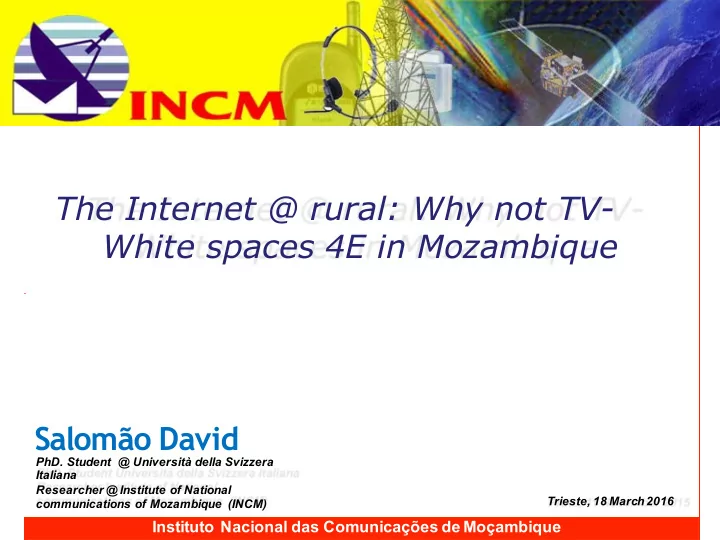

The Internet @ rural: Why not TV- White spaces 4E in Mozambique Salomão David PhD. Student @ Università della Svizzera Italiana Researcher @ Institute of National Trieste, 18 March2016 communications of Mozambique (INCM) Instituto Nacional das Comunicações de Moçambique
Instituto Nacional das Comunicações de Moçambique
Cognitive Radios • Cognitive radio is being intensively researched as the enabling technology for primary access to the so-called TV- White Spaces (TVWS) in the Sub-Saharan Africa (SSA) (Kawade & Nekovee, 2010; Mfupe et al., 2013; Mikeka et al., 2014). • TV- White Spaces has the satisfactory capability to make connectivity both technical and economically feasible in rural Africa (Zennaro et al., 2013). Instituto Nacional das Comunicações de Moçambique
Spectrum • Thespectrum provision in the SS Ais based on a static allowance of frequency bands to application entities in specific geographical areas for extended periods of time. • Nonetheless, cognitive radio is a radio technology capable of exploiting under-utilized radio spectrum by allowing secondary users to use this spectrum whenever without interfering with the primary users (Ahuja et al., 2008). Instituto Nacional das Comunicações de Moçambique
White Spaces • White spaces refer to regions of radio spectrum not used in a particular geographical location. Instituto Nacional das Comunicações de Moçambique
The Internet@ Rural • The cost of fiber optic deployment hampers the deployment of Internetin rural areas. • The Internet in rural Mozambique is done with the support of WiMax technology transmitted via 2.3 GHz – 2.6 GHz frequency band. • The high frequencies (2.3 GHz – 2.6 GHz) used by WiMax reduce the wavelength not allowing coverage for long distance, also having problems to bend the propagation around obstacles. • The telecommunication services provided in Mozambique are disproportionately clustered in metropolitan areas, suggesting that the forces of competition moreover are not reaching rural zones. Instituto Nacional das Comunicações de Moçambique
The ICT4E • We analyzed the present situation of the ICT4E project, and in particular districts and administrative posts of rural Mozambique, we grasped that ICT4EisprovidedonlyintheoryandfocusesoneducationforICTinsteadof ICT4E • Several challenges hinder the efficient provision of the ICT4E in rural Mozambique zones as for example, the cost of infrastructure, maintenance,availabilityandstabilityofelectricity ,learningframeworks, andsocio-cultural resistances. Instituto Nacional das Comunicações de Moçambique
TV-White Space • TV white spaces (TVWS) has been recently used as a leapfrogging wireless communication technology to provide broadband communication in rural areas smoothly while the Wi-Fi and broadcast spectrum is already exploited (Mikeka et al., 2014). • "Why not use TV-white spaces in rural Mozambique”? (Carlsoon Connect, 2014). Instituto Nacional das Comunicações de Moçambique
Why not TV-White Spaces • The sub-Saharan region has advanced in the quest for alternative low-cost wireless technologies underscored by the deep understanding of the difficulties to access the Internet in rural areas. With countries from the Sub-Saharan Africa (SSA) like South Africa (Masonta et al., 2012) and Malawi (Mikeka et al., 2014; Zennaro et al., 2013) deploying and expanding TVWStrial projects,a question emerges: • "Why not use TV-white spaces in rural Mozambique”? Instituto Nacional das Comunicações de Moçambique
Instituto Nacional das Comunicações de Moçambique
The Boane district • A drive test was conducted using Radio Frequency (RF) Signal Tracker to analyse the existence of White Spaces in utilized spectrum portions and to carry out spectrum measurements of the UHF and VHF frequencies. • The tracking process was carried with the understanding that most TV signals are vertically polarized. • Radio propagation analysis were conducted to predict his coverage of TV stations and the threshold-based on the minimum field strength, the methodology adopted to determine accurately the availability of TV White Spaces (Wang, 2014). Instituto Nacional das Comunicações de Moçambique
Drive Test • The data was latter crossed with the data available at the INCM, the Mozambican regulator for the postal and telecommunication sector. The drive test was carried to scan the frequenciesof 400Mhz to 700Mhz. Instituto Nacional das Comunicações de Moçambique
Deployment Instituto Nacional das Comunicações de Moçambique
Conclusions • The findings from the drive test suggest that there exists a larger amount of white spaces in the Boane municipality compared to Maputo. Most of the telecommunication services, as expected, are concentrated in the Maputo and Matola Province. • The underlying results demonstrate the existence of white spaces, and a range of assigned UHF channels not being used by specific entities. • The results demonstrate also that cognitive radios can be assigned to manage radio spectrum more efficiently by using this user’s licensedfrequency bands when the assignedusers are not transmitting. Instituto Nacional das Comunicações de Moçambique
• The deployment of a trial TVWS in the Boane Municipality is a challenge not only for manufacturers but also for spectrum regulators, rural communitiesand ISPs. • The spectrum regulator will have to create competitive regulations for the use of white spaces in remote and geographically challenged villages in Mozambique. • IS Ps will have to reformulate their business plans and activities to join the regulator on trials for new technologies for rural areas. Nevertheless, it is the responsibility of the Universal access funds (FSAU) to probe for the introduction of new and innovative technologies for rural Mozambique. Instituto Nacional das Comunicações de Moçambique
The way forward • Expansion 4morestates. • Createconditions forlocal content(DataCenters); • Monitoring;
Thank You Instituto Nacional das Comunicações de Moçambique
Recommend
More recommend